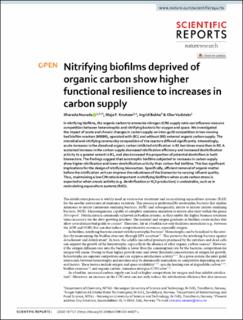| dc.contributor.author | Navada, Sharada | |
| dc.contributor.author | Knutsen, Maja F. | |
| dc.contributor.author | Bakke, Ingrid | |
| dc.contributor.author | Vadstein, Olav | |
| dc.date.accessioned | 2020-11-05T08:05:56Z | |
| dc.date.available | 2020-11-05T08:05:56Z | |
| dc.date.created | 2020-04-28T20:22:12Z | |
| dc.date.issued | 2020 | |
| dc.identifier.issn | 2045-2322 | |
| dc.identifier.uri | https://hdl.handle.net/11250/2686484 | |
| dc.description.abstract | In nitrifying biofilms, the organic carbon to ammonia nitrogen (C/N) supply ratio can influence resource competition between heterotrophic and nitrifying bacteria for oxygen and space. We investigated the impact of acute and chronic changes in carbon supply on inter-guild competition in two moving bed biofilm reactors (MBBR), operated with (R1) and without (R0) external organic carbon supply. The microbial and nitrifying community composition of the reactors differed significantly. Interestingly, acute increases in the dissolved organic carbon inhibited nitrification in R1 ten times more than in R0. A sustained increase in the carbon supply decreased nitrification efficiency and increased denitrification activity to a greater extent in R1, and also increased the proportion of potential denitrifiers in both bioreactors. The findings suggest that autotrophic biofilms subjected to increases in carbon supply show higher nitrification and lower denitrification activity than carbon-fed biofilms. This has significant implications for the design of nitrifying bioreactors. Specifically, efficient removal of organic matter before the nitrification unit can improve the robustness of the bioreactor to varying influent quality. Thus, maintaining a low C/N ratio is important in nitrifying biofilters when acute carbon stress is expected or when anoxic activity (e.g. denitrification or H2S production) is undesirable, such as in recirculating aquaculture systems (RAS). | en_US |
| dc.language.iso | eng | en_US |
| dc.publisher | Nature Research | en_US |
| dc.relation.uri | https://rdcu.be/b3PXu | |
| dc.rights | Navngivelse 4.0 Internasjonal | * |
| dc.rights.uri | http://creativecommons.org/licenses/by/4.0/deed.no | * |
| dc.title | Nitrifying biofilms deprived of organic carbon show higher functional resilience to increases in carbon supply | en_US |
| dc.type | Peer reviewed | en_US |
| dc.type | Journal article | en_US |
| dc.description.version | publishedVersion | en_US |
| dc.source.volume | 10 | en_US |
| dc.source.journal | Scientific Reports | en_US |
| dc.identifier.doi | https://doi.org/10.1038/s41598-020-64027-y | |
| dc.identifier.cristin | 1808539 | |
| dc.relation.project | Norges forskningsråd: 247558 | en_US |
| dc.relation.project | Norges forskningsråd: 270888 | en_US |
| dc.description.localcode | © The Author(s) 2020. This article is licensed under a Creative Commons Attribution 4.0 International License, which permits use, sharing, adaptation, distribution and reproduction in any medium or format, as long as you give appropriate credit to the original author(s) and the source, provide a link to the Creative Commons license, and indicate if changes were made. Te images or other third party material in this article are included in the article’s Creative Commons license, unless indicated otherwise in a credit line to the material. If material is not included in the article’s Creative Commons license and your intended use is not permitted by statutory regulation or exceeds the permitted use, you will need to obtain permission directly from the copyright holder. To view a copy of this license, visit http://creativecommons.org/licenses/by/4.0/. | en_US |
| cristin.ispublished | true | |
| cristin.fulltext | original | |
| cristin.fulltext | original | |
| cristin.qualitycode | 1 | |

